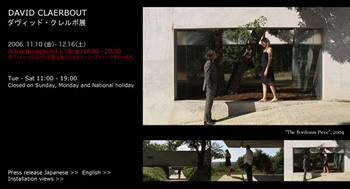 2006 11.10 - 12.26
2006 11.10 - 12.26

Installation >>
David Claerbout
Fri 10th November - 16th December 2006
Artist reception + Panel discussion (David Claerbout x Taro Amano) : 18:00 - 20:00
nca | nichido contemporary art is pleased to present David Claerbout’s solo exhibition in Tokyo, Japan. The exhibition is curated by Taro Amano as the first project of “Curator’s eye Vol. 1” in nca | nichido contemporary art. The show will present “The Bordeaux Piece” and “Untitled (Mist over Landscap)".
David Claerbout, Or the World as Phenomenon:
In the art of David Claerbout there is always an undercurrent of time and narrative running through the works like a continuo. With these themes as a base, the artist turns his eyes to phenomenon of the everyday world.
Claerbout began his art studies in painting and although he is known today for his film-like images, there remains a strong painterly influence in the compositions of his works. When people stand in front of Claerbout’s works, they feel like they are looking at paintery photographs. This is because we feel first of all the stillness of the images, as long as there is no clear passage of time involved. For example, in his first animated work, Ruuno, Bocurloscheweg, 1910, the image is of two human figures standing by a large tree in southern Holland from a picture postcard. The composition is one that reminds us of 17th century Dutch landscape paintings, but we realize that there is one clear difference: the leaves of the tree are moving.
To borrow the expression of the French philosopher Roland Barthes, Claerbout perceives photography as a medium that provides a proof of existence through absence. And, he too, is aware that for all his subjects, to be taken in a photograph is a proclamation of death. This also means that the subject when photographed becomes fact, and is thus assigned to history. Since the postcard he uses was photographed in 1910, the people in it are probably dead now. On the other hand, the large tree is probably still there, and Claerbout expresses that fact by using animation to make only the tree’s leaves move. As an expression of the present, he has prevented the tree alone from being taken into the suspended time of the image.
Born in 1969, Claerbout created the first of the works that are connected to his present style in 1996. Since 2000, he has shifted from working with photographs to video works in which he films actual people and landscapes. However, his sensitive use of music in his works is a stance that has not changed from the period of his photograph-based works. Don’t expect to see any clear story development or dramatic events in Claerbout’s video works. What you will see, however, is a use of sound that moves the characters through emotive nuance, while the music serves to express changes in emotion.
The work that Claerbout presents this time, The Bordeaux Piece, is a 12-minute work composed of 64 separate films. That means it would actually take the viewer 12 hours and 40 minutes to see the entire work. The films are filmed at 12-minute intervals and in fact they continue to shoot the same single scene from the same camera angle, so it appears to be a single loop at first. However, is it virtually impossible to recognize that time lag by watching the finished work. It is only the minutely moving light (sun) that brings subtle change to the repetitious film images.
As we already pointed out, there is no clear story development to be seen in Claerbout’s works. Rather, he seems to be showing us uneventful scenes of everyday life. That is the very reason that we try to find meaning in the specific subjects that appear I the images when we watch a work by Claerbout. Indeed, there are subjects appearing in these scenes he films that have some meaning of their own, but rather than those subjects, Claerbout places first priority on the passage of time and the light that makes us visually aware of it as the means for recognizing the world as phenomenon. Once we take this fact in mind, we can begin to have a true encounter with the works of David Claerbout.
By Taro Amano (Curator of Yokohama Museum of Art)
Gallery hours are Tuesday through Saturday, 11:00 am to 19:00 pm
David Claerbout:
Born 1969 in Kortrijk, Belgiu, Lives and works in Antwerp and Berlin
Nationaal Hoger Instituut voor Schone Kunsten, Antwerp 1992-1995
Recent solo exhibition: Centre Georges Pompidou, espace 315, Paris, 2007, nca | nichido contemporary art, 2006, Akademie der Kunst, Berlin, 2005, Dundee Contemporary Arts Centre, Dunde, 2005, Van Abbemuseum, Eindhoven, 2005, Le Magasin, Musee Dauphinois, Grenoble, 2005, Galerie Yvon Lambert, 'Visible Time', New York, 2005, Kunstbau im Lehnbachhaus, Munich, 2004, Art Gallery of Windsor, Windsor/CAN, 2004, Herbert Read Gallery, Canterbury/GB, 2004 and so on.
Taro Amano:
Born in Osaka in 1955. After working for the Hokkaido Museum of Modern Art from 1982 to 1987, Amano was appointed curator of the Yokohama Museum of Art in 1987.In this position he has been involved in the planning and execution of numerous exhibition, both in Japan and abroad. Amano is also a member of the Art Critics Association. Among the main exhibitions he has participated in the planning of are the "New York, New Art of the Chase Manhattan Bank Collection" (1989), "Print Art from the Kenneth Tyler Print Studio" (1992), Postwar Japanese Avant-garde Art" (1994), "Moving Out, Robert Frank" (1995), "Yasumasa Morimura Exhibition - The Sickness unto Beauty" (1996), "Contemporary Photography I - Lost Landscapes" (1997), "Louise Bourgeois Exhibition" (1997-98), "Yvon Lambert Collection" (1998), "Kishio Suga" (1999), "Contemporary Photography II - Anti-Memory" (2000), "Yoshitomo Nara Exhibition" (2001), "Jean-Marc Bustamante Exhibition" (2002), "Black Out: Contemporary Japanese Photography" (Japan Foundation, 2002-03), "Takuma Nakahira Exhibition” (2003), "Contemporary Photography III -Non-sect Radical" (2004), International Triennale of Contemporary Art YOKOHAMA,(2005)